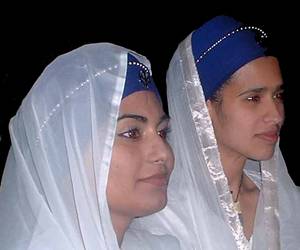Khimaar
From Speakeasy
Khimaar the Arabic term for a woman's headcovering. This is also more commonly called hijab in the West. The term hijab is more a word for the whole concept of modesty and the entire outfit a woman or man wears rather than just the headscarf. It can also refer to a specific type of headscarf, pictured below.
Contents |
Headcoverings in Islam
Surah al-Ahzab ayah 59 says:“ Ya ayyuha an-Nabiyy qul li azwajika wa banatika wa nisa al-mu'minin yudnina alayhinna min jalabibihinna; thalika adna an yu'rafna fa laa yu'thayn. Wa kana Allahu Ghafuran Rahima
O Prophet! Say to your wives and your daughters and the women of the faithful to draw their outergarments (jilbabs) close around themselves; that is better that they will be recognized and not annoyed. And God is ever Forgiving, Gentle.
Headcoverings in other religions
Judaism
A married Jewish woman must not show her hair to anyone except her husband or her young children. Orthodox Jews still follow this practice, either by covering the hair with a hat, wig or headwrap. Reform Jewish women typically do not cover their heads.
Christianity
The Bible mentions that a woman who is married should cover her head. A Christian woman must also be silent in church. How many Christians follow these rules anymore? Very few. The Virgin Mary is always depicted with a headcovering and a modest robe. The Catholic church used to promote "Marylike" dress for women while inside the church participating in Mass and other rites. Nothing is really said of what women ought to wear while not praying or when outside of church, except that it should be "modest" (which remains undefined) and must not imitate men. The lack of a Christian dress code outside of church makes little sense, since women are relatively safer in church than in any other place. A woman's dress gets her into trouble (unwanted sеxual advances, stares, rude jokes, and even rape) outside of church, while walking somewhere alone, or while at work. Most nuns and some Mennonites and other groups within Christianity practice the covering of the head.
Hinduism
A particularly interesting aspect of Indian family life is purdah (from the Hindi parda, literally, curtain), or the veiling and seclusion of women. In much of northern and central India, particularly in rural areas, Hindu and Muslim women follow complex rules of veiling the body and avoidance of public appearance, especially in the presence of relatives linked by marriage and before strange men.
For almost all women, modest dress and behavior are important. Clothing covering most of the body is common; only in tribal groups and among a few castes do women publicly bare their legs or upper bodies. In most of the northern half of India, traditionally dressed women cover the tops of their heads with the end of the sari or scarf (dupatta ). Generally, females are expected to associate only with kin or companions approved by their families and to remain sеxually chaste.
Sikhism
The most common head covering for Sikh women is the round turban and a chunni. Some Sikh women wear both, while some wear either turban or chunni. Sikhs do not usually wear red or green. The most common colors worn by Sikhs are White, Blue and Black. The old and/or spiritual people usually wear white. Black and blue are the most common colors worn by the youth. The main purpose of the head covering is to cover the head. The choice of colors is totally up to the individual.








